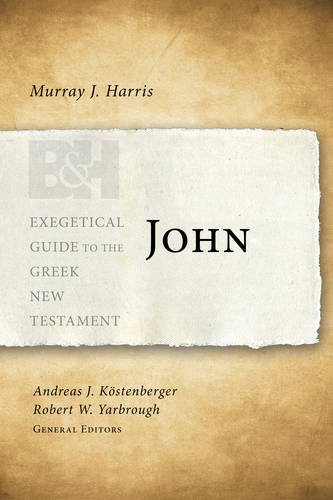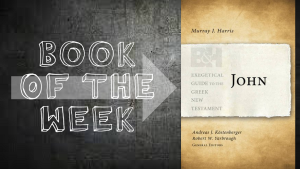The following is an excerpt from Murray Harris’ exegetical guide to John’s Gospel, our Book of the Week for December 14, 2015 (pp. 14-15, posted with permission, images and links added).
RECOMMENDED COMMENTARIES
Throughout this Guide references are made to five commentaries that are written in English or translated into English and are based directly on the Greek text of John. They are:
C. K. Barrett, The Gospel according to St. John: An Introduction with Commentary and Notes on the Greek Text. 2nd ed. Philadelphia: Westminster, 1978.
G. R. Beasley-Murray, John. 2nd ed. Word Biblical Commentary. Nashville: Thomas Nelson, 1999.
R. E. Brown, The Gospel according to John: Introduction, Translation, and Notes (i–xii; 1966); (xiii–xxi). Anchor Bible. Garden City, NY: Doubleday, 1970.
A. J. Köstenberger, John. Baker Exegetical Commentary on the New Testament. Grand Rapids: Baker, 2004.
R. Schnackenburg, The Gospel According to St John. Volume One: Introduction and Commentary on Chapters 1–4. ET K. Smyth. Freiberg: Herder/Montreal: Palm, 1968; Volume Two: Commentary on Chapters 5–12. ET C. Hastings et al. London: Burns and Oates, 1980; Volume Three: Commentary on Chapters 13–21. ET D. Smith and G. A. Kon. London: Burns and Oates, 1982.
Observations on these five commentaries
1 . The purpose and layout of these commentaries differ greatly, but in general, of the older commentaries, Beasley-Murray is the simplest in content and style and Barrett the most complex, with Brown closer to Beasley-Murray and Schnackenburg closer to Barrett. By church affiliation Brown and Schnackenburg are Roman Catholic, Barrett is Methodist, and Beasley-Murray is Baptist. More recent is Köstenberger (Baptist), who achieves a balance between historical, literary, and theological matters (see pp. 3–6 of his commentary).
. The purpose and layout of these commentaries differ greatly, but in general, of the older commentaries, Beasley-Murray is the simplest in content and style and Barrett the most complex, with Brown closer to Beasley-Murray and Schnackenburg closer to Barrett. By church affiliation Brown and Schnackenburg are Roman Catholic, Barrett is Methodist, and Beasley-Murray is Baptist. More recent is Köstenberger (Baptist), who achieves a balance between historical, literary, and theological matters (see pp. 3–6 of his commentary).
2. Accurate original translations are offered by Brown, Beasley-Murray, Köstenberger and Schnackenburg, with Brown’s rendering the most readable
and creative of the four.
3. Exegetical comments on specific verses are most easily found in Barrett (verse by verse) or Brown (under “Notes”).
4. Brief comments on textual variants are most conveniently available in Beasley-Murray (under “Notes”) at the beginning of each section and Köstenberger at the end of a given unit, although the fuller Metzger’s Textual Commentary remains the most authoritative treatment.
5. Theological observations on each section are best found in Beasley-Murray (under “Explanation”). Köstenberger wrote a sequel to his commentary, Theology, to which frequent reference is made throughout this volume as well and which includes thorough discussions of many significant theological themes in John’s Gospel and letters.
6. Bibliographies in various languages are provided at the beginning of each section in Beasley-Murray and at the end of each section in Brown (see also the thematic bibliographies in Köstenberger, Theology).
7. Schnackenburg, Brown, and Barrett interact in considerable detail with the various rearrangement and dislocation theories about the FG and the issue of possible sources of the material in the FG and how the author may have used them. But each of these commentators readily acknowledges the hypothetical nature of the theories discussed.
References to other commentators have sometimes been included—Bernard, Bruce, Carson, Dodd, Haenchen, Keener, McHugh, Michaels, Morris, Plummer, Ridderbos, and Westcott.
Murray Harris' guide to the best commentaries on John and their various strengths Share on X Other commentaries on John’s Gospel are listed in Beasley-Murray (1999) xxvi–xxvii, xcv, and there is a comprehensive chronological list of commentators in W. E. Mills, vol. IV, The Gospel of John (Lewiston, NY: Mellen Biblical Press, 1995), 363–76 of Bibliographies for Biblical Research: New Testament Series, ed. W. E. Mills. For an evaluation of the major commentaries on John in English, using helpful symbols, see Burge 181–85. For bibliographies of general literature (in several languages) relating to the background and exegesis of this Gospel, see Beasley-Murray xxviii–xxxi, xcv–xcix (who also conveniently provides a relevant bibliography at the head of each section of his commentary); Haenchen 2:254–346; S. P. Kealy, John’s Gospel and the History of Biblical Interpretation, 2 vols. (Lewiston, NY: Mellen Biblical Press, 2002); Keener 1251–1409; Köstenberger 607–40; and also G. Wagner, An Exegetical Bibliography of the New Testament, vol. 3: John and 1, 2, 3 John (Macon, GA: Mercer University, 1987); G. van Belle, Johannine Bibliography 1966–1985: A Cumulative Bibliography on the Fourth Gospel (Brussels: Leuven University, 1988), which updates E. Malatesta, St. John’s Gospel, 1920–1965 (Rome: Pontifical Biblical Institute, 1967); W. E. Mills (see above), up to 1993; and most recently S. E. Porter and A. K. Gabriel, Johannine Writings and Apocalyptic: An Annotated Bibliography (Leiden: Brill, 2013).
Other commentaries on John’s Gospel are listed in Beasley-Murray (1999) xxvi–xxvii, xcv, and there is a comprehensive chronological list of commentators in W. E. Mills, vol. IV, The Gospel of John (Lewiston, NY: Mellen Biblical Press, 1995), 363–76 of Bibliographies for Biblical Research: New Testament Series, ed. W. E. Mills. For an evaluation of the major commentaries on John in English, using helpful symbols, see Burge 181–85. For bibliographies of general literature (in several languages) relating to the background and exegesis of this Gospel, see Beasley-Murray xxviii–xxxi, xcv–xcix (who also conveniently provides a relevant bibliography at the head of each section of his commentary); Haenchen 2:254–346; S. P. Kealy, John’s Gospel and the History of Biblical Interpretation, 2 vols. (Lewiston, NY: Mellen Biblical Press, 2002); Keener 1251–1409; Köstenberger 607–40; and also G. Wagner, An Exegetical Bibliography of the New Testament, vol. 3: John and 1, 2, 3 John (Macon, GA: Mercer University, 1987); G. van Belle, Johannine Bibliography 1966–1985: A Cumulative Bibliography on the Fourth Gospel (Brussels: Leuven University, 1988), which updates E. Malatesta, St. John’s Gospel, 1920–1965 (Rome: Pontifical Biblical Institute, 1967); W. E. Mills (see above), up to 1993; and most recently S. E. Porter and A. K. Gabriel, Johannine Writings and Apocalyptic: An Annotated Bibliography (Leiden: Brill, 2013).
In spite of its erudition, E. A. Abbott’s Johannine Grammar (London: Black, 1906) is not a reliable guide to the subject. On many occasions his views on particular passages are decidedly improbable, if not eccentric, and his argumentation abstruse. I have therefore chosen not to give references to his work, even where I judge his exegetical conclusions to be reliable.
Read about how you can use Harris’ volume to guide you through significant exegetical issues in John’s Gospel.

Also check out more of our Annotated Bibliographies.
